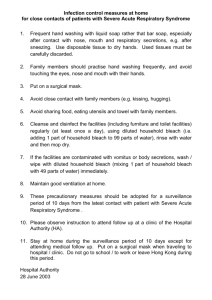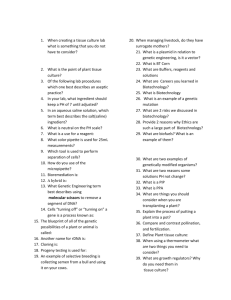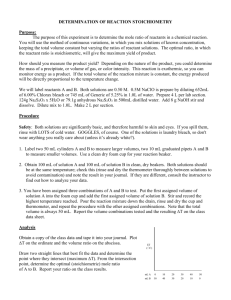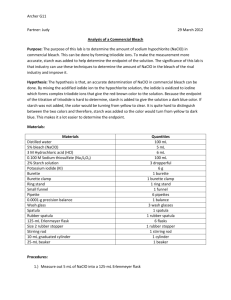Appendix 9 - CCBC Faculty Web
advertisement
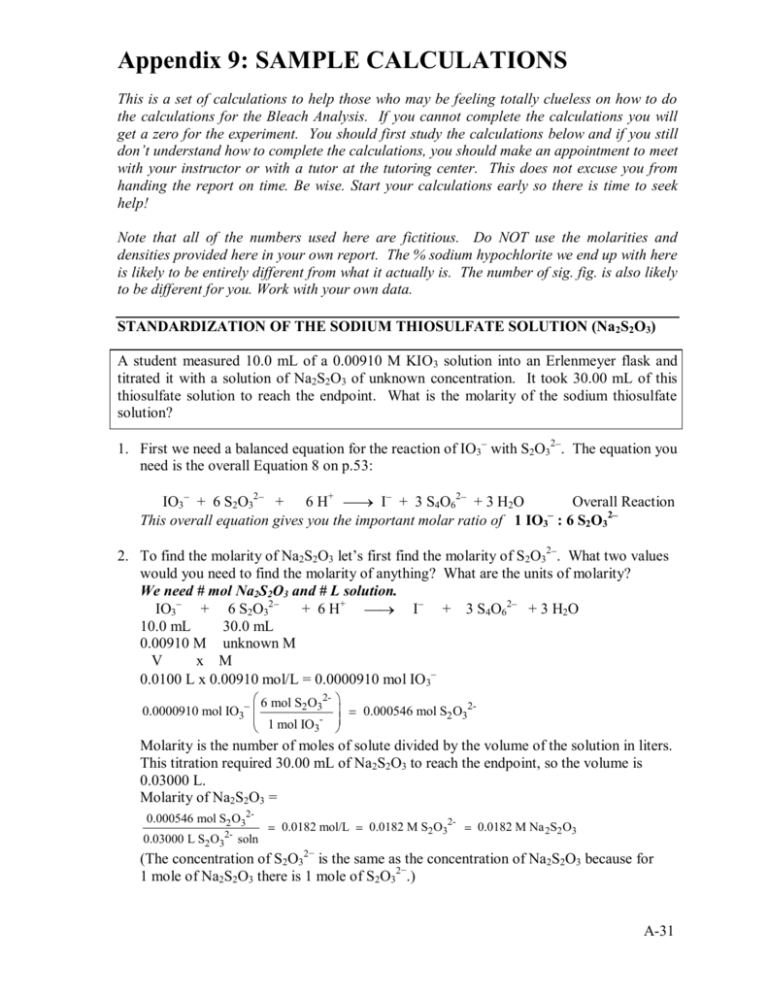
Appendix 9: SAMPLE CALCULATIONS This is a set of calculations to help those who may be feeling totally clueless on how to do the calculations for the Bleach Analysis. If you cannot complete the calculations you will get a zero for the experiment. You should first study the calculations below and if you still don’t understand how to complete the calculations, you should make an appointment to meet with your instructor or with a tutor at the tutoring center. This does not excuse you from handing the report on time. Be wise. Start your calculations early so there is time to seek help! Note that all of the numbers used here are fictitious. Do NOT use the molarities and densities provided here in your own report. The % sodium hypochlorite we end up with here is likely to be entirely different from what it actually is. The number of sig. fig. is also likely to be different for you. Work with your own data. STANDARDIZATION OF THE SODIUM THIOSULFATE SOLUTION (Na2S2O3) A student measured 10.0 mL of a 0.00910 M KIO3 solution into an Erlenmeyer flask and titrated it with a solution of Na2S2O3 of unknown concentration. It took 30.00 mL of this thiosulfate solution to reach the endpoint. What is the molarity of the sodium thiosulfate solution? 1. First we need a balanced equation for the reaction of IO3 with S2O32 . The equation you need is the overall Equation 8 on p.53: IO3 + 6 S2O32 + 6 H+ I + 3 S4O62 + 3 H2O Overall Reaction This overall equation gives you the important molar ratio of 1 IO3 : 6 S2O32 2. To find the molarity of Na2S2O3 let’s first find the molarity of S2O32 . What two values would you need to find the molarity of anything? What are the units of molarity? We need # mol Na2S2O3 and # L solution. IO3 + 6 S2O32 + 6 H+ I + 3 S4O62 + 3 H2O 10.0 mL 30.0 mL 0.00910 M unknown M V x M 0.0100 L x 0.00910 mol/L = 0.0000910 mol IO3 0.0000910 mol IO3 6 mol S2 O321 mol IO3- 0.000546 mol S2 O32- Molarity is the number of moles of solute divided by the volume of the solution in liters. This titration required 30.00 mL of Na2S2O3 to reach the endpoint, so the volume is 0.03000 L. Molarity of Na2S2O3 = 0.000546 mol S2 O320.03000 L S2 O3 2- soln 0.0182 mol/L 0.0182 M S2 O32- 0.0182 M Na 2S2 O3 (The concentration of S2O32− is the same as the concentration of Na2S2O3 because for 1 mole of Na2S2O3 there is 1 mole of S2O32−.) A-31 A-32 APPENDIX 9: SAMPLE CALCULATIONS DETERMINATION OF THE PERCENT SODIUM HYPOCHLORITE IN BLEACH First the student prepared a one to ten dilution of the bleach. A 5.00 mL of this diluted bleach is then titrated with the Na2S2O3 solution that was previously standardized. (You would be using your AVERAGE molarity of Na2S2O3 determined in your standardization,) It took 40.00 mL of the Na2S2O3 solution to reach the endpoint. The density of diluted bleach was determined to be 1.20 g/mL. What is the mass % NaOCl in the original, undiluted bleach? 3. First we need a balanced equation for the reaction of ClO with S2O32 . The overall equation you need is Equation 6 on p.52: ClO + 2 S2O32 + H2O Cl + S4O62 + 2 OH Overall Equation Again, this overall reaction gives you the important molar ratio of 1 OCl : 2 S2O32 4. To find the mass % NaClO, what two values do we need? What units would they have? As usual, when we need to determine percent, you should be thinking… part % x 100 whole In this case, we want # g NaClO x100 # g diluted bleach We need # grams of NaOCl and # grams of diluted bleach. % NaClO = 2 S2O32 + H2O Cl + S4O62 + 2 OH 40.00 mL 0.0182 M (from standardization calculations above) ClO + 5.00 mL diluted bleach 5. We are going to first calculate the number of moles of NaClO in each trial: 0.04000 L x 0.0182 mol/L = 0.000728 mol S2O32 0.000728 mol S2 O32- 1 mol ClO2 mol S2 O32- 1 mol NaClO 1 mol ClO- 0.000364 mol NaClO 6. Next we are going to calculate the % NaClO in the diluted bleach: Mass of NaOCl in diluted bleach = 0.000364 mol NaClO 74.44 g NaClO 1 mol NaClO Mass of diluted bleach % NaOCl in diluted bleach 0.0271 g NaClO 5.00 mL dilutedbleach 1.20 g diluted bleach 1 mL diluted bleach 0.0271 g NaClO x 100 6.00 g diluted bleach 6.00 g diluted bleach 0.452 % NaClO in dilutedbleach 7. Now, we have the simple dilution problem where we can use C1V1 = C2V2 Think carefully, if C1 is 0.452% and we are looking for C2, what is V1 and what is V2 in this experiment? Note that C1 is for the dilute solution; therefore V1 must for the dilute solution. THINK CAREFULLY! How was the dilution made in the lab? EXACTLY HOW DID YOU DILUTE THE BLEACH? LOOK IT UP IN THE PROCEDURE AND USE THE CORRECT SIG. FIG. ANS. 4.52 % NaClO in this exercise. Do you know why?
